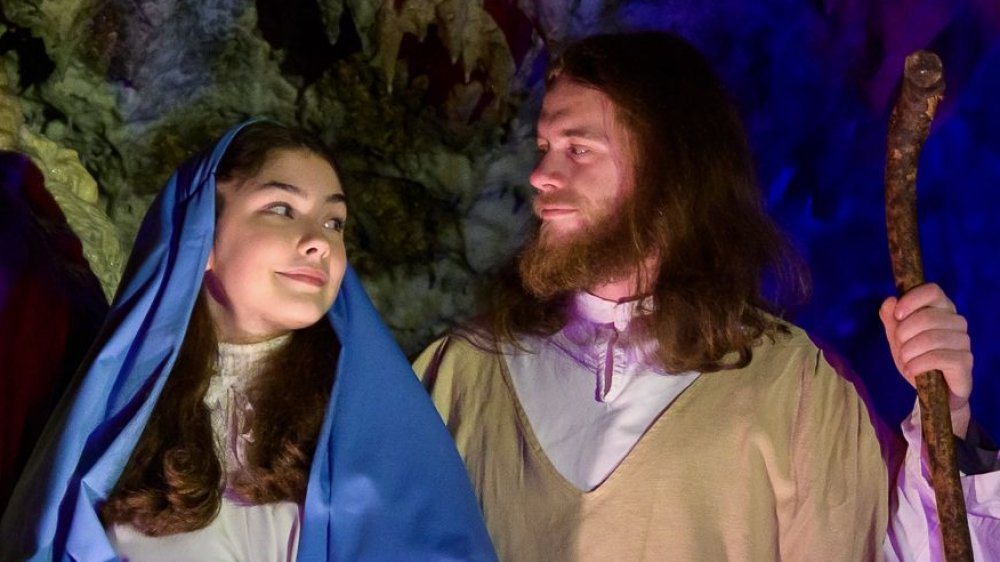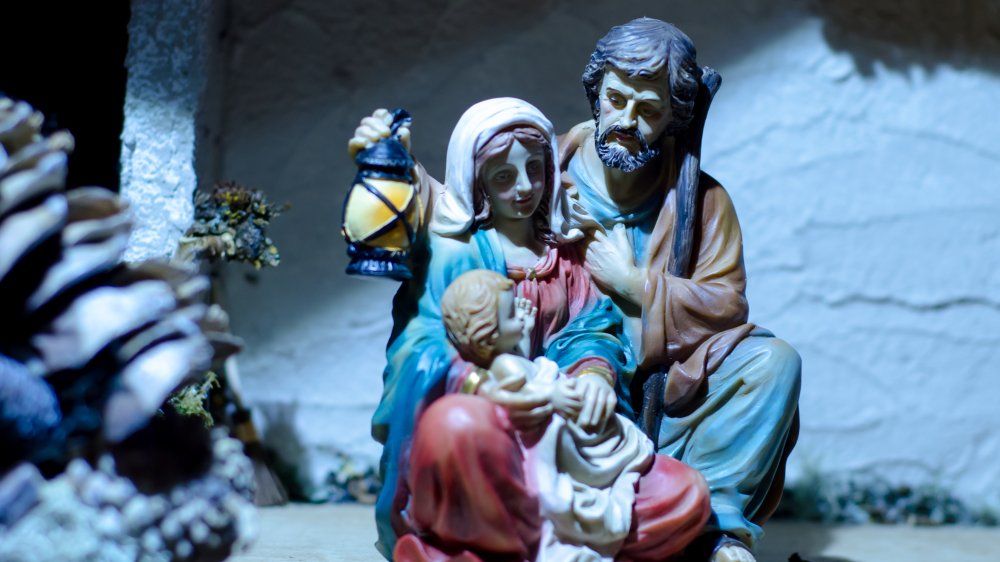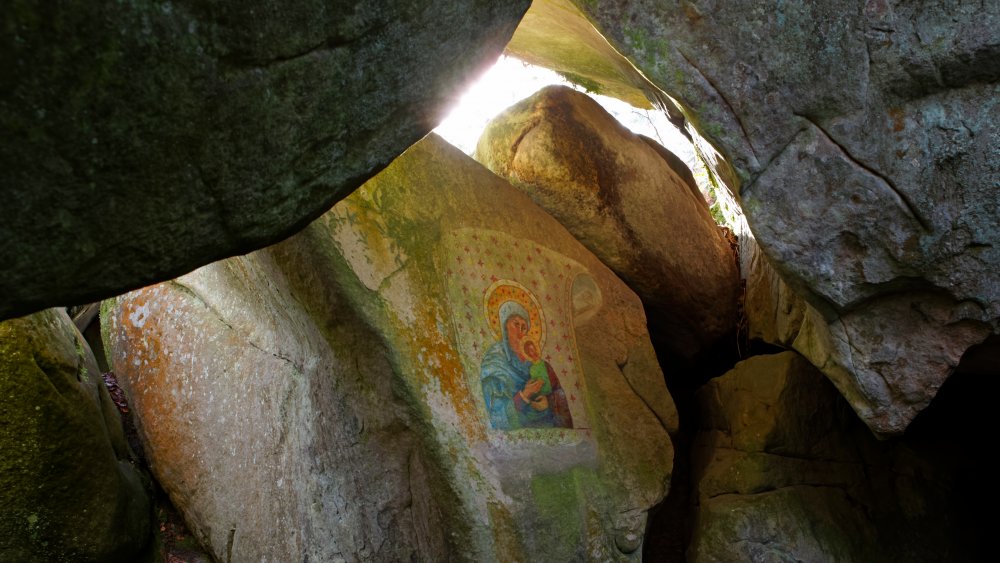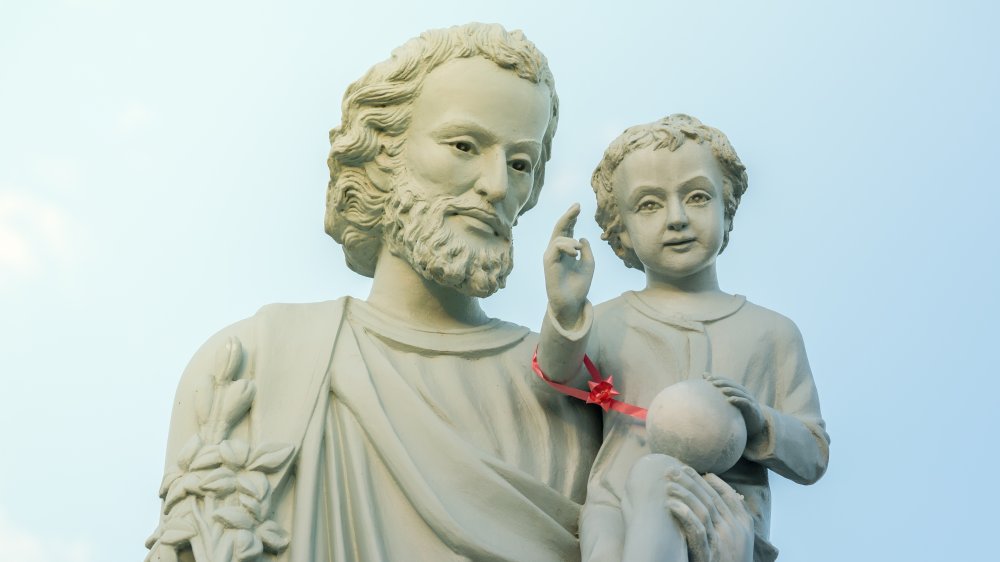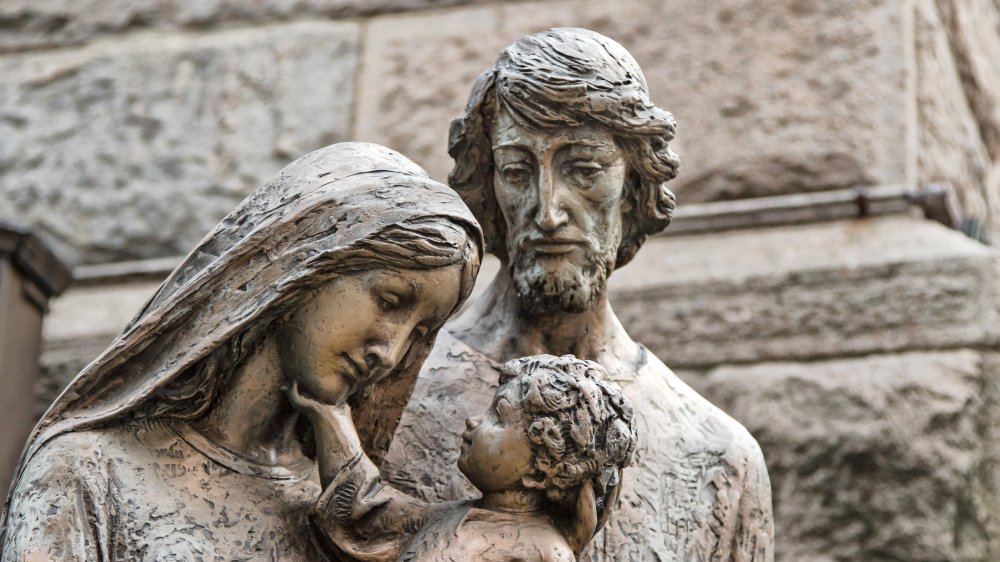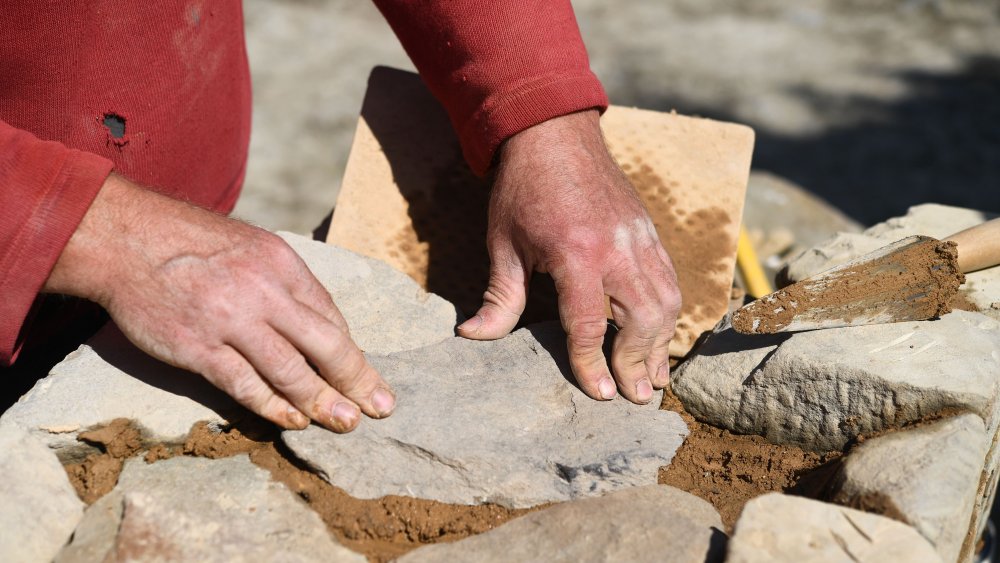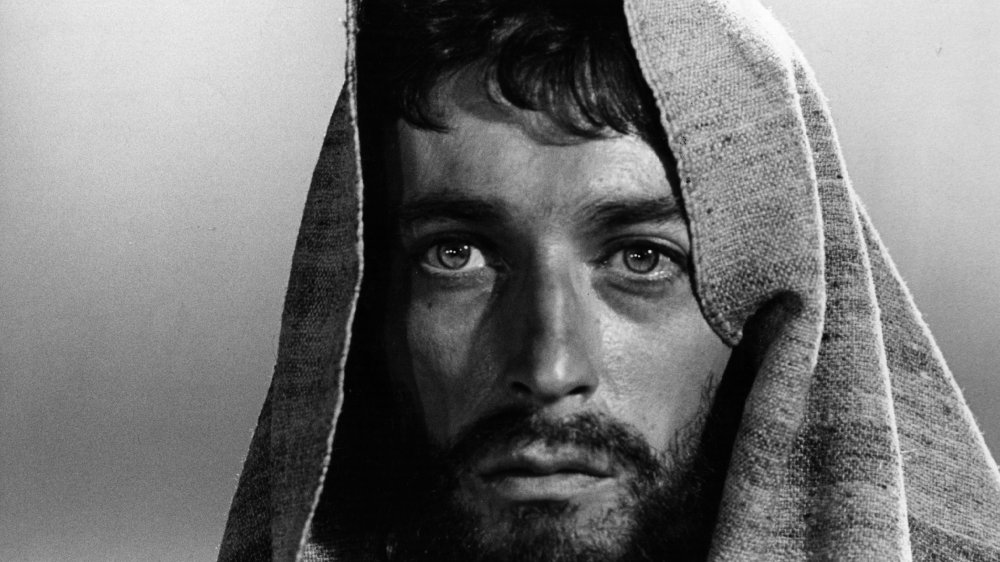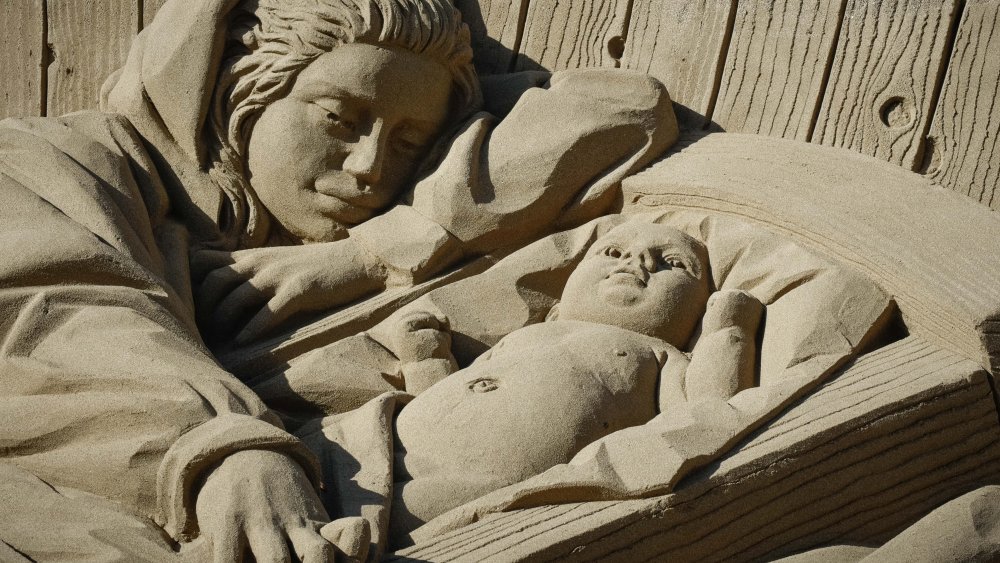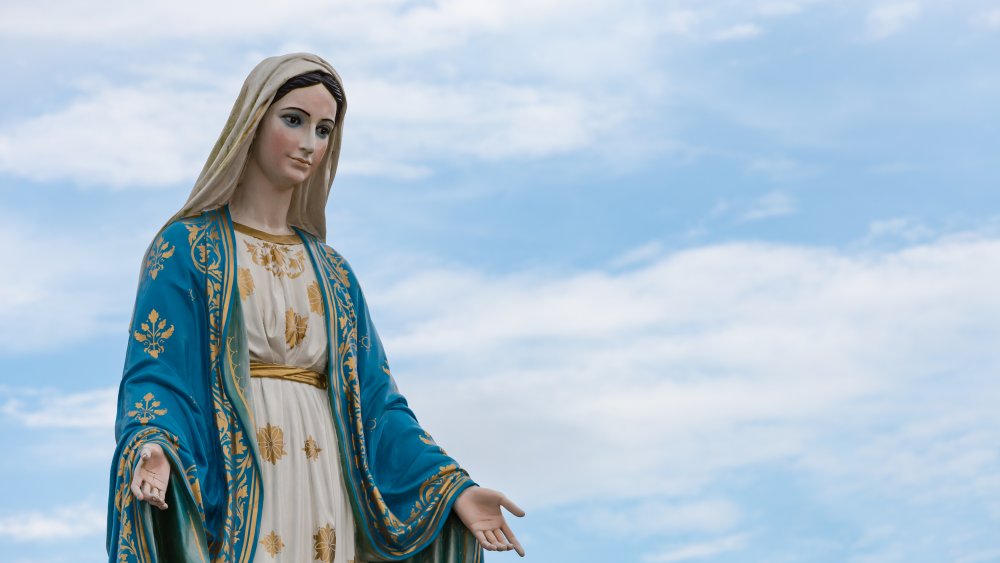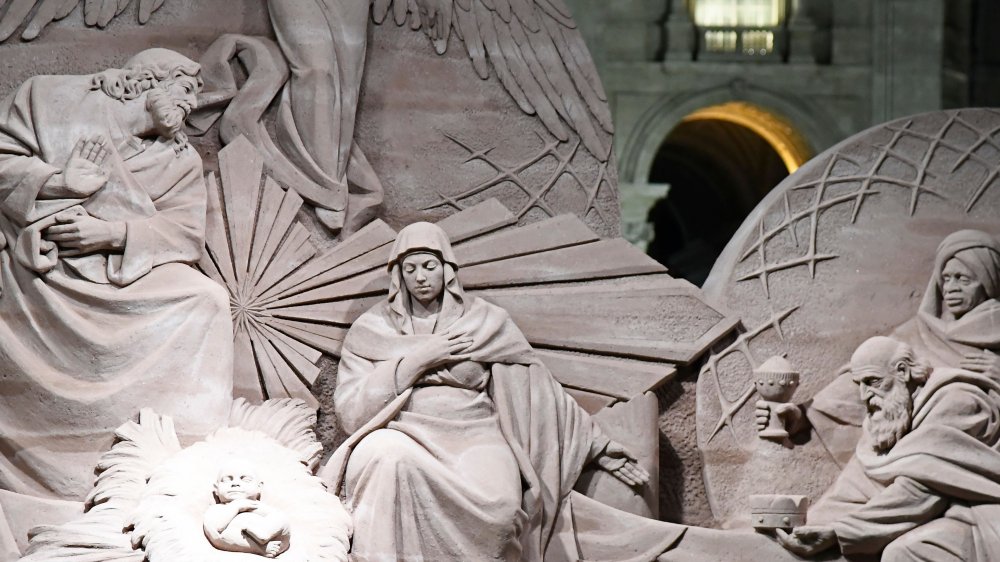The Untold Truth Of Mary And Joseph
By the time December rolls around, Christmas lights and wreaths have been set up for weeks and everyone wants Santa Claus to hurry his butt up. Christians are investing in their yard's nativity scene or making plans to see their neighborhood church's live nativity portrayal.
Even if you didn't hear the Nativity story every year, you're probably familiar with it. A girl named Mary gets pregnant by the Holy Spirit, her fiance decides to be a solid dude and be God's kid's stepfather, she and Joseph go to another city to get counted in a census, there's no room at the inn, and she gives birth to the son of God (Jesus) in a stable surrounded by cute animals. Then three kings from far away, led by a giant star pointing out where Jesus is, show up with expensive gifts (followed by random shepherds with no gifts). Zoom out on a sweet scene of the holy family. They have to flee to Egypt to escape a murderous king later. But all is calm and all is bright for now.
Cool story. But the truth about the two parents at the heart of the story is often brushed aside when talking about Christianity's main man. But whether or not you're a person of faith, Mary and Joseph are interesting characters. The historical details and context of their time make them way more interesting than the figures carrying a staff and riding a donkey in the movies.
They were only at the first stage of being engaged when Mary got pregnant
To understand Mary and Joseph's relationship, you have to understand the stages of Jewish marriage. Jews who want to have a marriage recognized by rabbinic tradition (called Mishnah Kiddushin), have to follow certain rules. Chabad describes Jewish marriage as being divided into two parts: kiddushin (getting engaged) and nisu'in (getting married in a ceremony).
But this is a very simplistic way to think about the process. To go through kiddushin means that you're essentially married in the eyes of God. You don't live with your fiancé at this point, and you definitely don't have sex. Nowadays, most people just combine kiddushin and nisu'in rituals into one wedding ceremony for the sake of efficiency and cost. But in Mary's time, this would have lasted a whole year and Joseph would have spent it reading holy texts and getting ready to be a husband. Imagine her showing up pregnant with all of that going on.
Fun fact: Jewish Press reported that Sephardi Chief Rabbi Yitzchak Yosef sent a letter out saying that modern engagements where someone got down on one knee, asked for someone to marry them, and offered them a gift in front of witnesses basically counted as kiddushin. In essence, modern Jews were accidentally getting married in the eyes of Jewish law when they thought they were just proposing. Whoops.
They almost broke up because Mary was pregnant
In Mary and Joseph's time, women's purity was valued as a currency, something that would sweeten the deal between marriage negotiations in family. There were no paternity tests back then—if you wanted kids that you were sure were yours, the best insurance was marrying a virgin. So women's bodies were highly regimented during this time. There are several rules in the Bible about approaching women when she has kids and/or has a period. They would be considered "unclean" at various points and would have to avoid contact with people.
So imagine your girlfriend shows up after visiting her cousin for three months with a big ol' baby bump. Everyone, not just Joseph, was freaking out. Mary would have been considered damaged goods and not marriage material. It didn't help that she was claiming it was God's baby, not even that of a man other than Joseph. So he planned to end their engagement. According to National Geographic, Joseph was just trying to not make the situation worse.
But don't think Joseph was insensitive for wanting to dump Mary because she was unexpectedly pregnant. Breaking up was actually the classiest move Joseph could have made at that time (more on that later).
Without Joseph, Mary would have been stoned to death
Think about the story of the Nativity as if it happened today: Teenage girl from an extremely conservative society (when it comes to sex and women's rights) gets engaged, visits her cousin, and comes back visibly pregnant. Mary was an OG and kept to her story that the Holy Spirit had gotten her pregnant, but people were as skeptical of the idea back then as they would have been today.
Joseph tried to be nice about it—Matthew 1:19 describes how he planned to separate from her quietly so the public wouldn't shame her. But "shame her" is a nice way to say "stone her to death." Deuteronomy 22:21 and the surrounding verses lay down the law that if a girl had sex while living with her parents (i.e. unmarried), she would be stoned to death for bringing shame upon her family.
But Joseph didn't want this to happen to her. Later on, the angel Gabriel visited him in a dream and reassured him that yes, Mary actually was going to have God's kid. So Joseph doubled down on his Good Guy stance and took on Mary as his wife even though she was pregnant. Tablet describes how Joseph has taken on newfound popularity in modern times as people have realized just how important he was to keeping Mary safe. People have realized that without him, the birth of Jesus definitely wouldn't have happened.
Joseph saved Jesus's life as a baby
Once the angel visited Joseph and confirmed that Mary was really going to have God's kid, Joseph got on board immediately.
But this also extended to after the birth of Jesus. God, perhaps impressed by how chill Joseph had been throughout this whole ordeal, sent another angel to Joseph telling him that they had to pick up and leave immediately. He obeyed, and they fled what turned out to be a massacre of all kids in Bethlehem younger than two years old. King Herod (a.k.a. one of the best Sunday School villains) had sent people out to kill any child who might be the Messiah after running into the three kings on their way to visit Jesus. Couldn't handle any competition for the throne, apparently.
Joseph has been shoved aside in favor of the Virgin Mary in the eyes of a lot of believers, since she had to carry Jesus and bear the social stigma of the pregnancy. But that's beginning to change. In 2003, Pope John Paull II spoke about Joseph setting an example as someone who believed in the messages he received from God but also stayed humble and didn't seek attention as God's stepdad. The National Catholic Register sang his praises in 2011, recommending him as someone Catholics could go to for divine help in parenting.
Mary and Joseph didn't get intimate at all until after Jesus was born
It's explicitly stated in the Bible that Joseph and Mary didn't consummate their marriage until after Jesus was born and they bailed to Egypt. Which makes sense, since Mary was pregnant most of the time they were initially together. And getting freaky isn't really worth it if it means your girlfriend is stoned afterward.
But even this viewpoint is pretty revolutionary in terms of how believers view Mary. There's a healthy group of people, mostly Catholic, who believe that Mary never had sex ever. The "perpetual virgin" view of Mary is used as a way to honor her alleged holiness and purity as the mother of God.
National Catholic Register points out that people who believe this theory do so partly because of the lexicon surrounding families at the time. Whenever men are referred to as Jesus's "brothers" in the Bible, that doesn't necessarily mean that they're Jesus's brothers by blood. They could be his cousins or other family members. or maybe even his friends. People point out that people who referred to as Jesus's brothers by some people don't choose to identify themselves this way. Also, if it isn't obvious already, there are a lot of women in the Bible named Mary. It's always possible some family trees were lost in translation.
Joseph may not have strictly been a carpenter
This is another story about the life of Jesus that may have been altered through the lens of pop culture. It's quaint to picture Jesus learning how to build things out of wood with his dad. It's like they're alluding the imagery of the stable of his birth and his future death on a cross. It also fits the idea of Jesus's beginnings being humble. The Bible even tells a story of when Jesus was roasted in his hometown of Nazareth when he came back as an adult to perform miracles. They said things to the effect of, "Wait, how does the son of this carpenter know all these things? Where did he learn this?"
But Joseph may have actually been a secret badass. In the Ancient Greek that the Bible was translated from, Joseph is referred to as a tekton. According to A Greek-English Lexicon, tekton can mean a carpenter or wood-joiner but is commonly used to describe any craftsman or woodworker. Some theories allege that this means Joseph may have actually worked with stones or larger materials. An author cited in the Telegraph claimed that Joseph may have even been a master architect who provided Jesus a comfortable upbringing.
Their hometown of Nazareth was unusual for the time
If you're wondering why God chose an engaged teenage girl to carry his kid instead of, say, someone who was single and could give Jesus less of a difficult start, brace yourself.
Mary and Joseph were from Nazareth, a town in Israel that people literally made fun of in the Bible. John 1:46 gave us the immortal line of "Can anything good come out of Nazareth?" That was said by Nathanael, who went on to be a disciple after meeting Jesus in person.
But Nazareth was genuinely strange for a town of the time. Live Science reported that archaeological excavations of Nazareth suggest that the town wasn't as willing to embrace Roman tradition as the empire might like. Among the items found in a house was a set of limestone holding vessels, used by Jews because they believed that limestone was an incorruptible substance. The people of Nazareth were stubborn enough in their Jewish heritage that even when their country was being invaded by Rome, the people of didn't give up their Jewish traditions. Mary and Joseph likely grew up dedicated to their faith, which may have rubbed off on God's kid.
Mary and Joseph were both short and definitely had dark skin
Sorry to disturb anyone's assumptions, but Christ was not white. Jesus may have been played by white actors, but that's definitely not how it went down in real life.
A breakdown from Live Science suggests that if Jesus took after Mary at all, she would have had olive skin and was probably of average height for the time. Jews back then tended to marry other Jews, so she probably looked like other Israeli Jews or maybe with a slightly darker complexion (depending on whether her ancestors intermingled with people from Egypt.) She also would have been average looking, since the Bible is petty and specifically mentions whenever someone (like Daniel or Queen Vashti) is particularly attractive. Nice.
James Martin wrote in Slate that we can't forget that Mary was probably 14-years-old at the time when she gave birth to Jesus, something that was common for the time. She probably would have been arranged to be married around the time of her first period. Just in case you needed your Nativity scene to be even more awkward.
Jesus's birth was allegedly really difficult
Mary had it harder than most women when it came to childbirth, even when you consider the time period. She presumably had Joseph to help her. But she had no experienced midwives, which were available back then, according to The Jewish Woman. Mary also, thanks to circumstances, had to give birth in a smelly place outside of her own town away from her family.
That would be hard on anyone. But add on a difficult labor and it becomes a whole other story: In the Quran, Mary has to give birth with her back against a palm tree for support. She says out loud, "Oh, I wish I had died before this and was in oblivion, forgotten."
And no, that's not a typo—this story did come from the Quran, not the Bible. Mary has a big fan base in Islam. She has a whole chapter about her in the Quran and is the only woman mentioned by name, according to the BBC. Her chapter talks about the birth of Jesus and the immediate aftermath. It also features a sweet story about baby Jesus speaking up in his mom's defense when people say she wasn't a virgin, according to PRI.
Mary wearing blue is probably just symbolic
In case you haven't noticed, there are a lot of paintings of Mary. The young mom of Jesus has been featured in probably more paintings than anyone who ever lived (if she lived at all, a discussion for another time). In a lot of these paintings, Mary's portrayed wearing a light blue shawl or hijab. It's a light, airy color, not unlike the robe worn by her son in the most expensive painting on earth.
But is Mary's blue covering accurate to history? Probably not. The Schaff–Herzog Encyclopedia of Religious Knowledge confirms that clothing for women Israelites was lighter and more brightly colored than men's clothing. Assyrians of the time wore blue tunics as undergarments, but that was relatively far from Mary's 'hood.
Aleteia describes how Mary's blue covering is really an allusion to her purity and closeness to God. She doesn't wear the white of a saint or the red of a Jesus-killing emperor. Blue is the color of special woven tassels worn by Jews in that time to remind them to follow the Commandments. It's the color of the cover of the Ark of the Covenant. In short, Mary wears blue in paintings to symbolize that she is just that much holier than anyone else painted with her.
Joseph may have had a first wife before Mary
In Catholicism, there are lots of books beside the Bible that people debate over in terms of authenticity. Some people dismiss them outright. Other people take them in consideration alongside the Bible, much like how people who practice Kabbalah read other texts in conjunction with those of Jewish law. Some of these extra texts for Catholicism are called the apocrypha writings. Catholic Culture describes them as documents that didn't make it to the Bible compiled by people who wanted to know more about Jesus. Even if they're not true, they say a lot about what people thought about Jesus and his place in the culture not long after he was alive.
If these writings can be believed, Joseph had a first wife named Melcha. The Catholic Dictionary says that the apocrypha states that Joseph was a widower with six children, who asked to marry Mary after his wife died. This fits the pop culture image as Mary being much younger than him (not totally out of the ordinary at that time). It also fits with the idea of Mary being a perpetual virgin but Jesus still having brothers and sisters.
If it's true, it provides a very different image of Joseph: An older guy who's already done the marriage and babies thing who has this new wife who's pregnant somehow. But he still steps up to be the best stepdad in the Bible.
Jesus was born in a basement, not a stable
One of the most consistent parts of the Nativity story is that Mary had to give birth to Jesus in a stable full of animals. The town was full of people coming to Bethlehem, and apparently no one was nice enough to let a heavily pregnant woman take their adjoining suite. So they took the only space available.
Now, people of that region at this time didn't keep animals in stables the way we do today. Think of a home in biblical times as the ultimate open concept home: People would sleep up in what was essentially the second floor while doing chores and other everyday work on the base floor. The base floor was also where the animals were brought in at night. Newsweek reported that this was likely where Jesus was born, not in an entirely separate structure built outside of a house. What most likely happened was that Joseph showed up at his extended family's house, was told that there wasn't enough room in the sleeping quarters for Mary to give birth, and so they had to make do with the gross basement where the animals hung out. It wasn't so much people being monsters to a pregnant woman as much as Joseph's cousin Fred arrived early and scored the last couch.
Also: There's actually no proof of any cute animals surrounding Jesus, as reported by Yahoo. That's all pop culture portrayals.
